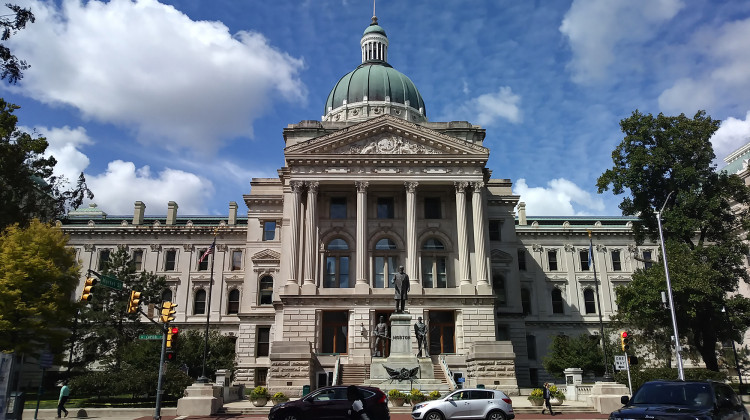It will still be weeks before Indiana lawmakers can gather to redraw congressional and state legislative district boundaries. That’s because of delays in getting necessary information from the U.S. Census Bureau.
But before the process starts, here are some of the basics of redistricting in the Hoosier State:
The Indiana Constitution requires the state legislature redraw state House and Senate district lines every 10 years, after the census. The requirement to draw congressional district borders is in state law. And the Constitution also says those state House and Senate districts must be "contiguous" – meaning a district can’t be split into pieces that don’t connect.
But beyond that, there are no other state laws that govern how the lines are drawn. There are some federal rules Indiana legislators must follow: districts have to be equal in population (or very, very close to it). And there are some guards against racial discrimination.
The districts drawn this year will be in place until after the next census, a decade from now.
This story is in response to questions we received through the Indiana Two-Way. To join, text "Indiana" to 73224.
Who is involved in the redistricting? How are they chosen and by whom?
The Indiana Constitution requires the state legislature to redraw state House and Senate district lines every 10 years. Those legislators are chosen through elections every two years (for House members) and four years (for senators).
Within the legislative process, the initial maps are typically drawn by the House and Senate election committees. The members of those committees are chosen by the House and Senate Republican and Democratic caucus leaders.
The balance of the committees is generally determined by the balance of the whole legislature. With Republican supermajorities in both chambers, GOP lawmakers far outweigh the number of Democrats on the committees.
Redistricting maps must be voted on and approved by both the Indiana House and Senate and then signed into law by the governor. Whichever party controls those entities (currently, Republicans) has an advantage in drawing the maps.
Why not go with a straight grid?
U.S. Supreme Court decisions in the 1960s established the modern system of redistricting. Those decisions require that the districts be equal in population, or very close to it. Creating a simple grid would not yield equal populations.
Join the conversation and sign up for the Indiana Two-Way. Text "Indiana" to 73224. Your comments and questions in response to our weekly text help us find the answers you need on statewide issues.
How did redistricting get started in the first place?
Redrawing district lines dates back to before the United States was founded. In this country, the history of redistricting varies widely before the 1960s, when the Supreme Court and the Voting Rights Act helped establish nationwide standards for drawing district boundaries.
How can redistricting be done so that neither party is favored?
Citizens and lawmakers of both parties have long advocated for an independent redistricting commission to draw Indiana’s legislative maps. They argue that taking the decision out of the hands of lawmakers will help ensure fairness.
However, such a proposal has never successfully advanced through the General Assembly. Over the last decade, it has been blocked – in some cases, even from debate – by Republican supermajorities as Democrats each year push for changes to Indiana’s redistricting system.
There is also some debate over whether an independent commission could draw the maps without changing the State Constitution. Some proposals have sought to circumvent that hurdle, without success.
What is the percentage of registered Democratic and Republican voters (and unaffiliated or independent) relative to representation in the state House and Senate?
Indiana voters, unlike in some other states, are not required to register with a party. A recent study compared statewide election results to the party breakdown in the legislature, concluding that the state’s current maps are skewed to favor Republicans.
How many seats will Indiana lose in Congress?
None. The number of Hoosier congressional districts will stay at nine, where it’s been since 2003.
Is anyone in Indiana, especially any elected official, trying to get our redistricting process changed to be nonpartisan?
There are advocacy groups – notably, the Indiana Coalition for Independent Redistricting – that fight every year to take redistricting out of the hands of lawmakers.
Democratic lawmakers have also advocated for changes. But GOP supermajorities, which control both chambers of the legislature, have been unwilling to enact reforms.
What do Republican leaders say about Indiana’s current redistricting system?
Republicans argue that the maps are fair and that Indiana has become, simply, a Republican-dominated state.
Do any states have a process for ensuring that redistricting is nonpartisan?
The redistricting process varies widely across the country. Some states, like Indiana, have lawmakers draw the districts. Others involve advisory groups, while still others have entirely independent commissions drawing legislative boundaries.
However, even independent commissions are not an absolute guarantee of "fair" maps.

What is the difference between a bipartisan commission and a nonpartisan commission?
Some use the terms interchangeably. But generally, a bipartisan commission is made up of members from the two major political parties – Democrats and Republicans. A nonpartisan commission is one which aims to include members who don’t have a political affiliation.
Some Indiana Republican leaders have expressed doubt that a nonpartisan commission is possible.
How can voters demand fair and equitable redistricting?
The General Assembly will have committee hearings on the proposed legislative maps in the coming weeks. Hoosiers can also always reach out to their elected representatives. You can find your state lawmakers on the General Assembly’s website, iga.in.gov.
The four legislative caucus leaders are Senate Republican leader Rodric Bray (R-Martinsville), Senate Minority Leader Greg Taylor (D-Indianapolis), House Speaker Todd Huston (R-Fishers) and House Minority Leader Phil GiaQuinta (D-Fort Wayne).
The chairs and ranking Democrats on the House and Senate Election Committees – the committee that the maps will be voted out of in each chamber – are Rep. Tim Wesco (R-Osceola), Rep. Tonya Pfaff (D-Terre Haute), Sen. Jon Ford (R-Terre Haute) and Sen. J.D. Ford (D-Indianapolis).
Contact reporter Brandon at bsmith@ipbs.org or follow him on Twitter at @brandonjsmith5.
 DONATE
DONATE








 Support WFYI. We can't do it without you.
Support WFYI. We can't do it without you.